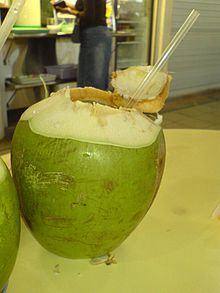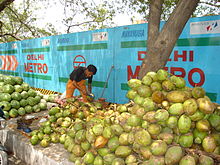- Coconut water
-
"Coconut juice" redirects here. For the song, see Coconut Juice (song).
 A young coconut, ready to drink as sold in Singapore.
A young coconut, ready to drink as sold in Singapore.
Coconut water is the clear liquid inside young coconuts (fruits of the coconut palm). As the fruit matures, the coconut water is gradually replaced by the coconut meat and air. A very young coconut has very little meat; the meat that it has is very tender, almost a gel. Coconut water has long been a popular drink in the tropics, especially in Southeast Asia, Pacific Islands such as Hawaii, Africa and the Caribbean, where it is available fresh, canned, or bottled.
Coconuts for drinking are carefully packaged and sold in many places. These are typically Asian coconuts whose outer green husk has been removed, and the remainder wrapped in plastic. Throughout the tropics they can be found sold by street vendors, often cut in front of customers to ensure the coconut water's freshness. Coconut water can also be found in ordinary cans, tetra paks, or plastic bottles (sometimes with coconut pulp or coconut jelly included). It is also being marketed as a natural sports drink because of its high potassium and mineral content.
Unless the coconut has been damaged, it is likely sterile. There have been cases where coconut water has been used as an intravenous hydration fluid in some developing countries where medical saline was unavailable.[1]
Contents
Composition
Nuts, coconut water Nutritional value per 100 g (3.5 oz) Energy 79 kJ (19 kcal) Carbohydrates 3.71 g - Sugars 2.61 g - Dietary fibre 1.1 g Fat 0.2 g Protein 0.72 g Water 94.99 g Vitamin A equiv. 0 μg (0%) - beta-carotene 0 μg (0%) - lutein and zeaxanthin 0 μg Thiamine (vit. B1) 0.03 mg (3%) Riboflavin (vit. B2) 0.057 mg (5%) Niacin (vit. B3) 0.08 mg (1%) Pantothenic acid (B5) 0.043 mg (1%) Vitamin B6 0.032 mg (2%) Folate (vit. B9) 3 μg (1%) Vitamin C 2.4 mg (3%) Vitamin E 0 mg (0%) Vitamin K 0 μg (0%) Calcium 24 mg (2%) Iron 0.29 mg (2%) Magnesium 25 mg (7%) Phosphorus 20 mg (3%) Potassium 250 mg (5%) Zinc 0.1 mg (1%) Percentages are relative to US recommendations for adults.
Source: USDA Nutrient DatabaseCoconut water has a high potassium content and contains antioxidants linked to a variety of health benefits.[2] Cytokinins in coconut water may be among its most beneficial components.[3]
Harvesting
Fresh coconuts for drinking are typically harvested off the tree while they are green. A hole may be bored into the coconut to provide access to the liquid and meat. In young coconuts the liquid and air may be under some pressure and may spray slightly when the inner husk is first penetrated. Coconuts that have fallen to the ground are susceptible to rot and damage from insects or animals.
Derivative products
Coconut water can be fermented to produce coconut vinegar. It is also used to make nata de coco.
See also
References
- ^ Campbell-Falck D, Thomas T, Falck TM, Tutuo N, Clem K (2000). "The intravenous use of coconut water". Am J Emerg Med 18 (1): 108–11. doi:10.1016/S0735-6757(00)90062-7. PMID 10674546.
- ^ Conis, Elena. (March 6, 2011). Coconut water: A health drink that's all it's cracked up to be?. Los Angeles Times. Retrieved March 24, 2011.
- ^ Yong, J. W. H.; Ge, L.; Ng, Y. F.; Tan, S. N. (2009). "The Chemical Composition and Biological Properties of Coconut (Cocos nucifera L.) Water". Molecules 14 (12): 5144–5164. doi:10.3390/molecules14125144. PMID 20032881.
- Petroianu, Georg A., Melita Kosanovic, Ibrahim Saad Shehatta, Bahaa Mahgoub, Ayman Saleh, Wolfgang H. Maleck (2004). Green coconut water for intravenous use: Trace and minor element content. Journal of Trace Elements in Experimental Medicine 17 (4): 273-82. PMID 14824551.C
- Ranti IS, Kwee Tien Boh, Thio In Liang, Tan Eng Hoey (1965). Coconut water for intravenous fluid therapy. Paediatr Indones. 5 (3): Suppl: 782-92. PMID 5873766.
Fruit juice Types of fruit juices Apple • Coconut • Cranberry • Grape • Grapefruit • Lemon • Lime • Orange • Pomegranate • Strawberry • Tomato Category:Fruit juice
Category:Fruit juice
This botany article is a stub. You can help Wikipedia by expanding it. This Non-alcoholic beverage-related article is a stub. You can help Wikipedia by expanding it.

